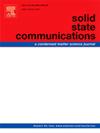Experimental and computational study of a hybrid phosphate crystal exhibiting a wide energy band gap: Structural, optical, and insight from Hirshfeld surface analysis and DFT calculations
IF 2.1
4区 物理与天体物理
Q3 PHYSICS, CONDENSED MATTER
引用次数: 0
Abstract
The crystal structure of C4H10NO3+.H2PO4− reveals a three-dimensional hydrogen-bonded network composed of dihydrogen phosphate anions, carboxyl groups, and ammonium groups, the molecular geometry of DLTDP was optimized using Becke's three-parameter hybrid functional, the Lee-Yang-Parr correlation functional (B3LYP) theory, and the 6-311G basis set. Additionally, fingerprint plots derived from the Hirshfeld surface were employed to explore the crystal's intermolecular interactions and the compound, H⋯H contacts appear as asymmetrically scattered dots, covering a large area of the two-dimensional FP maps, with a single broad peak at de = di ∼ 1.2 Å and a significant contribution of 33.6 %. O⋯H/H⋯O contacts, However, the volume occupied by these voids represents about 9.56 % of the volume of the unit cell. The nonlinear optical (NLO) properties of DLTDP were also theoretically predicted. Its electronic properties, including HOMO and LUMO energies, were computed to assess the charge transfer characteristics. Local reactivity descriptors, such as electrophilicity indices, were used to identify the most reactive sites. To investigate the electronic structure and intra/intermolecular charge transfer within the DLTDP molecule, Natural Bond Orbital (NBO) analysis was employed. This approach provided detailed insights into donor–acceptor interactions and the stabilization energies associated with electron delocalization. The nucleophilic and electrophilic regions were determined through molecular electrostatic potential (MEP) mapping and Fukui function analysis. The IR spectra exhibited a broad absorption band around 2350 cm−1, attributed to the O–H stretching vibration of the H2PO4− group, indicating the formation of hydrogen bonds between H2PO4− anions and N–H groups. In addition, the interaction of the investigated compound with COVID-19 target proteins was studied. Molecular dynamics simulations were performed over a time scale of 0–100 ns to analyze its interaction with the protein exhibiting the lowest docking energy. Finally, the DLTDP crystal showed an optical band gap of 5.87 ± 0.01 eV, indicating its potential suitability for optical applications due to its wide band gap.

具有宽能带隙的杂化磷酸盐晶体的实验和计算研究:结构、光学和来自Hirshfeld表面分析和DFT计算的见解
C4H10NO3+的晶体结构。采用Becke的三参数杂化泛函、Lee-Yang-Parr相关泛函(B3LYP)理论和6-311G基集对DLTDP的分子结构进行了优化。此外,来自Hirshfeld表面的指纹图谱被用来探索晶体的分子间相互作用和化合物,H⋯H接触出现为不对称的分散点,覆盖了二维FP图的大片区域,在de = di ~ 1.2 Å处有一个宽峰,显著贡献为33.6%。O⋯H/H⋯O接触,然而,这些空隙占据的体积约占晶胞体积的9.56%。对DLTDP的非线性光学特性进行了理论预测。计算了其电子性质,包括HOMO和LUMO能量,以评估电荷转移特性。局部反应性描述符,如亲电性指数,被用来识别最活跃的位点。为了研究DLTDP分子的电子结构和分子内/分子间电荷转移,采用了自然键轨道(NBO)分析方法。这种方法为供体-受体相互作用和与电子离域相关的稳定能量提供了详细的见解。通过分子静电势(MEP)作图和福井函数分析确定亲核区和亲电区。红外光谱显示出2350 cm−1左右的宽吸收带,这归因于H2PO4−基团的O-H拉伸振动,表明H2PO4−阴离子与N-H基团之间形成了氢键。此外,我们还研究了该化合物与COVID-19靶蛋白的相互作用。在0-100 ns的时间尺度上进行分子动力学模拟,以分析其与具有最低对接能量的蛋白质的相互作用。最后,DLTDP晶体显示出5.87±0.01 eV的光学带隙,表明其具有宽带隙的光学应用潜力。
本文章由计算机程序翻译,如有差异,请以英文原文为准。
求助全文
约1分钟内获得全文
求助全文
来源期刊

Solid State Communications
物理-物理:凝聚态物理
CiteScore
3.40
自引率
4.80%
发文量
287
审稿时长
51 days
期刊介绍:
Solid State Communications is an international medium for the publication of short communications and original research articles on significant developments in condensed matter science, giving scientists immediate access to important, recently completed work. The journal publishes original experimental and theoretical research on the physical and chemical properties of solids and other condensed systems and also on their preparation. The submission of manuscripts reporting research on the basic physics of materials science and devices, as well as of state-of-the-art microstructures and nanostructures, is encouraged.
A coherent quantitative treatment emphasizing new physics is expected rather than a simple accumulation of experimental data. Consistent with these aims, the short communications should be kept concise and short, usually not longer than six printed pages. The number of figures and tables should also be kept to a minimum. Solid State Communications now also welcomes original research articles without length restrictions.
The Fast-Track section of Solid State Communications is the venue for very rapid publication of short communications on significant developments in condensed matter science. The goal is to offer the broad condensed matter community quick and immediate access to publish recently completed papers in research areas that are rapidly evolving and in which there are developments with great potential impact.
 求助内容:
求助内容: 应助结果提醒方式:
应助结果提醒方式:


